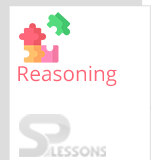 Introduction
Introduction
In verbal series, words, letters or digits are given in a specific sequence/order and we have find out next word, letter or digit to complete the given series. Numbers or Alphabetical letters, are generally called terms of the series. The article Alphabetical and Number Series Practice Quiz 5 provides information about Alphabetical and Number Series, a important topic of Reasoning Consists of different types Alphabetical and Number Series questions with solutions useful for candidates preparing for different competitive examinations like RRB. RRB ALP/Technical Exams/Junior Engineer Recruitment Exams, SSC CGL, SSC CHSL, IBPS, SBI PO, SBI Clerks, CAT and etc.
 Quiz
Quiz
1. Choose the correct alternative from the given ones that will complete the series NPQ, HJK, BDE, ?
- A. RTU
B. VXY
C. KMN
D. WYZ
- A. IKH
B. IGK
C. JHL
D. JGL
- A. DFI
B. CEI
C. DFJ
D. CFJ
- A. U
B. T
C. V
D. W
- A. RTQ
B. RSU
C. RTU
D. RST
1. Which of the following options must continue the series?
CE, GJ, OX, ?
- A. PF
B. OF
C. OV
D. PE
- A. SDV
B. IHQ
C. SEY
D. PDU
- A. AD
B. CG
C. CF
D. BF
- A. 84
B. 82
C. 79
D. 88
- A. 136.25
B. 142.25
C. 146.25
D. 156.25
1. 6, 16, 34, 62, 102, ?
- A. 156
B. 132
C. 136
D. 142
- A. 97
B. 85
C. 108
D. 64
- A. 80
B. 82
C. 120
D. 121
- A. 110
B. 114
C. 115
D. 125
- A. 65
B. 64
C. 66
D. 62




